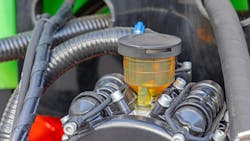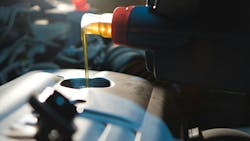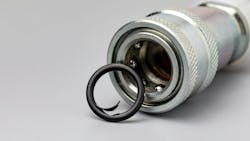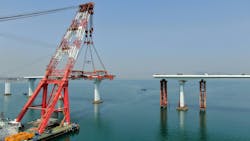Next-Gen Biodegradable Hydraulic Fluids Overcome Performance Challenges
Demand for sustainable solutions continues to grow in many industries, including those utilizing hydraulic fluids. This, paired with increased regulatory requirements around the world, has prompted ongoing developments in the area of biodegradable hydraulic fluids.
Rebecca Zwetzig, Sector Manager for Chevron Industrial Lubricants, said these fluids must meet environmental standards but not compromise on performance or the hydraulic fluid’s ability to protect equipment.
Striking the right balance between these requirements has not always been easy. But advancements in base oils, additives and other components are helping to bring about a new generation of biodegradable hydraulic fluids capable of meeting both sustainability and performance needs.
What is a Biodegradable Hydraulic Fluid?
The U.S. Environmental Protection Agency (EPA) has established criteria for environmentally acceptable lubricants (EAL), the term it uses for lubricants like hydraulic fluid that meet standards for biodegradability, toxicity and bioaccumulation potential to minimize environmental impacts.
EAL are typically categorized as being either readily or inherently biodegradable. Testing methods established by various standards organizations consider readily biodegradable fluids as those which achieve biodegradation up to 60% or higher within a 28-day period whereas inherently biodegradable versions show 20% or higher biodegradability (the breakdown of a chemical by micro-organisms) during that same time period.
Readily biodegradable hydraulic fluids are what many developers aim for as it offers better assurance there will be minimal environmental impact if a leak occurs, which is likely to happen at some point with a hydraulic system. “We all know nobody wants stuff leaking out there, even though it does happen, which is why we have this environmental regulation to make sure that the products can be readily biodegradable,” said Zwetzig.
“The main reason the EPA wanted 60% or greater biodegradability is [because] a hydraulic fluid on that 28-day journey could biodegrade up to 35% and then sit [at that percentage] for years,” said Ben Garmier, Vice President of Renewable Lubricants — a developer of biodegradable lubricants and greases. “It may not biodegrade further than that.
“Sixty percent was a number they figured out that once you get to that point within a 28-day period they assume that within the next year the product is going to biodegrade to basically nothing into the soil,” he said.
EAL also need to be non-toxic, meaning they have passed testing demonstrating a fluid will not kill bugs or other organisms with which it may come in contact. They must also meet standards for bioaccumulation. “They don’t want any heavy metals that will accumulate in soil or waterways over time,” explained Garmier.
He said older hydraulic fluids typically had zinc in them which is a heavy metal. If these fluids leaked at any point or even slowly dripped into the soil over an extended period of time “you could have a large piece of soil contaminated with zinc heavy metals. So, that’s why they have that last standard.”
Choosing the Right Formula for Sustainability and Performance
Zwetzig explained that hydraulic fluids are comprised of two key components: a base oil and additives. “It's those two things combined that will allow that product to have certain performance attributes,” she said.
Garmier noted that often the base oil is one of the most important components of hydraulic fluid. Therefore, selecting the right one can have significant implications on overall performance.
Most of the biodegradable hydraulic fluids in the market today are made with either a vegetable (natural ester) or a synthetic ester base oil. “A vegetable [base oil] is great because it's renewable, but it tends to have a shorter lifespan because it breaks down with high temperatures, or what we call thermal degradation, and [these oils] oxidize rapidly,” she said.
Too much oxidization can cause the oil to become acidic, which can be harmful to equipment she explained. “So, you have to change that fluid more frequently.”
Frequent oil changes can be costly in terms of both price and downtime required; it also leads to more waste.
Synthetic esters last longer than their vegetable base oil counterparts, said Zwetzig. However, they do not play well with various polymers, including those used in the rubber hoses and seals utilized in many machines. “It can cause that seal to become hard, or it can change the size of that seal, which means that it can lead to breakdowns in the equipment as well as leakage of that hydraulic fluid,” she said.
She noted that synthetic esters are also considered a hydroscopic fluid which means they like to attract and retain water. These base oils already by their nature have a high water content. As such, the overall life of the hydraulic fluid can be reduced if it absorbs too much water. In addition, the fluid may not be able to provide enough rust or corrosion protection as well as cause premature failure.
New Base Oil Achieves Best of Both Worlds
For Chevron’s most recent biodegradable hydraulic fluid, the Clarity Bio EliteSyn AW, the company chose to use a renewable synthetic base stock. “It’s made with 85% or greater synthetic,” said Zwetzig. “The best way I can explain it is that it’s very similar to a renewable PAO or polyalphaolefin.”
PAO is a synthetic base oil known for its ability to be used in extreme temperatures, high viscosity index and good oxidation stability, among other benefits.
Zwetzig said Chevron developed this new biodegradable fluid because it recognized a gap in the industry. “Many of the biodegradable fluids out there today are lacking the ability to be durable. They have some seal compatibility issues, [and] they don't necessarily have the best hydrolytic stability or air release,” she said. “Many original equipment manufacturers are coming out with fluid cleanliness [requirements] as well, so you have to be able to filter and clean this product to make sure that you're not damaging it with contaminants in those systems.”
Through its use of a renewable synthetic base oil Chevron was able to create a hydraulic fluid capable of meeting the most stringent of environmental regulations as well as desired performance characteristics such as seal compatibility and hydrolytic stability.
Additionally, it was important to create a fluid that is affordable — otherwise customers won’t use it — and which works with existing hydraulic systems. “You can't create something that's so new that it doesn't work in the equipment out there today,” she said.
Watch our video interview with Zwetzig below to learn more about the development of biodegradable hydraulic fluids and the Clarity Bio EliteSyn AW.
Considerations for Developing Cold Temperature Biodegradable Hydraulic Fluids
It is also important for a biodegradable hydraulic fluid to be capable of working in various temperatures, from very hot to very cold. The latter are the type of environments for which Renewable Lubricants has developed its Bio-Ultimax 1200LT Hydraulic Fluid.
Understanding Pour Point
Pour point is a laboratory test conducted to indicate at what point a hydraulic fluid gets cold and starts to freeze.
Garmier explained that the pour point is determined by placing a container of hydraulic fluid in a freezer. The temperature in the freezer is continually adjusted to colder temperatures until a point at which the fluid no longer moves or pours out of the container because it is frozen. “Once you get to where you can't turn [the hydraulic fluid] anymore and it doesn't move, that's your pour point,” he said.
While this is a good test, he noted it is done in a laboratory setting and variations can occur such as the starting temperature for the test which can impact how the fluid actually performs in the real world. Therefore, Garmier said it is important to discuss with customers what the testing data means and how it translates to real-world use.
Just because a data sheet notes a certain pour point for a hydraulic fluid “that doesn't necessarily mean [customers] could take their system down that low,” said Garmier. The actual working conditions will be a determining factor such as whether a machine has been operating for several hours or sitting overnight. If the latter, it’s likely the hydraulic fluid will still freeze because it has not been in use and needs to be warmed up before it will work as desired.
“It was developed for [hydraulic systems] used in the northern hemisphere…the northern part of the U.S. and up into Canada and Alaska,” said Garmier. The hydraulic fluid features a cold temperature pumpability down to -40 C (-40 F) and pour point as low as -60 C (-76 F). (See sidebar for more information on pour point.)
For the Bio-Ultimax 1200LT fluid, he said the company uses synthetic ester base oil because vegetable base oils are not capable of working in very cold temperatures. A biosynthetic formula is used to ensure biodegradability. “We like to have 50% or greater renewable base oils so that they’re more sustainable because there are ways to meet the EPA [standards] with non-sustainable base oils,” he said. “You can get biodegradability even with some petroleum base oils.”
Then various hydraulic additives for anti-wear, extreme pressure capabilities and more are blended in. This combination allows the fluids to meet the EPA’s standards for a readily biodegradable lubricant as well as customer performance needs.
Like Zwetzig, he noted the careful formulation which must be taken when using synthetic esters to ensure compatibility with seals used in the hydraulic system. “There's a balance because some of the base oils like to dry the seals out, causing cracking and leaking,” he explained. “And some of them actually do the opposite; the rubber in the seals like to absorb the base oil which causes them to expand.”
Garmier said seal conditioning properties are included in the Bio-Ultimax 1200LT fluid to ensure the right balance is achieved to prevent the seals from drying out or absorbing too much oil. He noted that with several of the colder temperature hydraulic fluids in the marketplace, users need to be careful about the types of seals they have in their systems. “Whereas the Bio-Ultimax 1200LT works with the majority of the major seals that are in hydraulic systems.”
He also said many of the non-biodegradable cold temperature hydraulic fluids in the market are very caustic and are typically thinner because a thin fluid will not freeze as easily. However, this can lead to some performance compromises such as flammability. Another benefit of the Bio-Ultimax 1200LT is that it has a very high flash point, making it less flammable than other cold temperature options and thus usable in environments where this may be a concern.
Advancements in Oil Technologies are Shifting Perspectives on Biodegradable Hydraulic Fluids
Renewable Lubricants has been developing biodegradable products for 30 years, but Garmier said he’s seen a ramp up in interest for such solutions over the past 10 years. Although government regulations have played a part, he said the private sector has really been the driver for increased use of sustainable solutions.
For instance, the people building a new bridge over a river may also fish in that same water and so want to protect that environment when working in it.
There is a generational shift taking place as well, he noted. When his dad started the business, the environment was not necessarily at the forefront of the conversation. But younger generations like Garmier’s are more open to looking at the environmental impacts of things. “They want nice, clean waterways,” he said. “And that’s just been a societal thing that’s changed. Because of that we’ve seen a lot more interest in [biodegradable hydraulic fluids].
“Biodegradable [and] environmentally friendly lubricants is probably the fastest growing space in lubricants,” he said. “And over the next 10 years it's only supposed to continue to grow.”
Aiding the growth and capabilities of biodegradable hydraulic fluids is the continued advancements taking place in base oil and additive technologies. “Every year we get new base oils arriving in the market that are sustainable and higher performing,” said Garmier. “They have better performance with water, with heat; they have better oxidation.”
He said some of the original biodegradable hydraulic fluids that came out years ago had 1/10th of the oxidation — essentially the longevity of a fluid in a system — of regular hydraulic fluid. “So, customers were changing them out a lot more to meet the standard they needed for their system.”
Performance issues were common with the earlier generations of biodegradable hydraulic fluids which he said made a lot of people hesitant to use them. There was a stigma in the beginning, but over the last 5-10 years this has started to go away as a range of lubricants capable of meeting various performance needs have entered the marketplace.
There are a number of new environmentally friendly additive suppliers entering the market as well. Garmier said it used to be there was one zinc-free hydraulic additive option but now there are several. This is due in part to the additives industry moving away from using zinc not necessarily because of the environmental impact but instead it just wanting to utilize the next best thing from a technological perspective.
Also prompting the increase in suppliers has been the rise in companies developing biodegradable lubricants in recent years. With more developers working in this space, suppliers see opportunities to provide them the additives they need.
“And that's how the market starts to shift. I would say it's definitely the market itself starting to push,” the development of biodegradable hydraulic fluids and its necessary components, concluded Garmier.
About the Author
Sara Jensen
Executive Editor, Power & Motion
Sara Jensen is executive editor of Power & Motion, directing expanded coverage into the modern fluid power space, as well as mechatronic and smart technologies. She has over 15 years of publishing experience. Prior to Power & Motion she spent 11 years with a trade publication for engineers of heavy-duty equipment, the last 3 of which were as the editor and brand lead. Over the course of her time in the B2B industry, Sara has gained an extensive knowledge of various heavy-duty equipment industries — including construction, agriculture, mining and on-road trucks —along with the systems and market trends which impact them such as fluid power and electronic motion control technologies.
You can follow Sara and Power & Motion via the following social media handles:
X (formerly Twitter): @TechnlgyEditor and @PowerMotionTech
LinkedIn: @SaraJensen and @Power&Motion
Facebook: @PowerMotionTech






